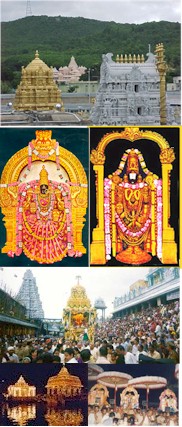Welcome to Adiyen Sri Ramanuja Dasan !
" Srimathe Ramanujaya Namaha !"
(94. Q. Contd...) Bhagavatham and Adisesha - The Bhagavatam takes the form of a story being told by a great rishi known as Suta Goswami, to a host of assembled sages, who ask him questions in regard to the various avatars, or descents of Vishnu within the mortal world. Suta, then relates the Bhagavatam as he has heard it from another sage, called Suka.
Each section or canto describes specific avatars of Vishnu, beginning with a summary of all avatars in the first canto. The tenth and eleventh cantos give detailed accounts of the story of Krishna's appearance and pastimes in Brindavan, and his instructions to various devotees (such as the Uddhava Gita). The final twelfth canto foretells the coming of the age of Kali yuga (the current age according to the Hindu cycle of ages), and the eventual destruction of the earthly universe.
The Bhagavatam describes the various leelas of twenty-five avataras (incarnations) of Vishnu. In Hindu (Vedic) tradition, Shesha is the king of all nagas, one of the primal beings of creation, and according to the Bhagavata Purana, an avatar of the Supreme God known as Sankarshan. In the Puranas, Shesha is said to hold all the planets of the Universe on his hoods and to constantly sing the glories of Vishnu from all his mouths. He is sometimes referred to as "Ananta-Shesha" which means "Endless Shesha."
"Sri Ananta has 10 thousand faces and is fully independent. Always ready to serve the Supreme Personality of Godhead, He waits upon Him constantly. Sankarshana is the first expansion of Vasudeva, and because He appears by His own will, He is called svarat, fully independent. He is therefore infinite and transcendental to all limits of time and space. He Himself appears as the 10 thousand-headed Sesha.
Shesha is generally depicted with a massive form that floats coiled in space, or on the universal ocean, to form the bed on which Vishnu lies. Sometimes he is shown as five-headed or seven-headed, but more commonly as a many hundred-headed serpent, sometimes with each head wearing an ornate crown.
95. Q .: Swamy, please let us know, what actually is the meaning of Thiru. most of the Vaishnavait temple cities are named after Thiru. Whatz the reason.
Ans .: 'Thiru' in tamil means 'Sri'. this word is used generally to prefix while giving respect to a person, place etc.. Like 'thiru' Manmohan singh. And for places it is used to give ample respect and divinity by adding the prefix 'Sri' (or Thiru).
Jai Srimannaryana !
Thanks for your valuable time. Visit our web site again for more information and latest updates.

